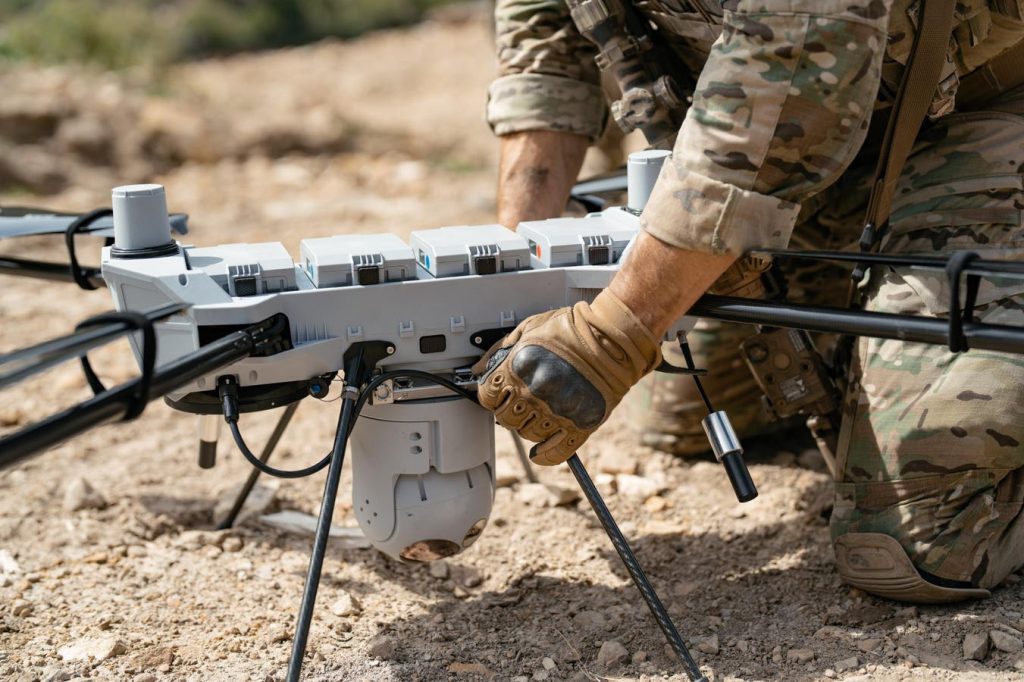Last month Performance Drone Works (PDW) won a contract to supply small drones to the U.S. Army, beating out tough competition from primes like General Dynamics and other established suppliers. This is quite an achievement for a small, little-known outfit, and much of the credit goes to the vision of PDW CEO and Co-founder Ryan Gury.
Gury is a lifelong drone enthusiast who sees them as a transformational capability –- “arguably the biggest change in airpower since WWII,” he says – and points to the way drones have come to dominate the war in Ukraine. He is committed to supplying U.S. forces with low-cost, ‘consumable’ drones at scale, unlike the boutique, expensive models currently in use. His company is supply with Army with the C-100 multi-mission drone which comes with a whole slew of new capabilities.
Air Force In A Rucksack
Gury has been deeply involved from the beginning of the modern drone era. In 2015 he co-founded the Drone Racing League, a leading forum for the world’s elite pilots. He holds multiple patents for drone technologies and was recognized by Guinness World Records for the fastest drone in 2017. (Years later similar racing quadcopters would be adapted into the deadly FPV kamikazes now seen everywhere in Ukraine).
But it takes more than technology to build a product suited to the end user, and Gury notes that the PDW team includes experienced Tier 1 military drone operators who fed directly into the design process. They made sure that rather than fancy gadgets, the engineers focused on what users wanted.
“The C-100 was designed backwards from a rucksack,” Gury told me.
The drone was engineered for the maximum capability that could be easily carried by one soldier. The result is a quadcopter with folding rotors, a much larger beast than the usual pocket-sized camera drones, capable of carrying a 10-pound payload and with a flight endurance of up to 74 minutes.
That payload capacity and flight time make the C-100 a true mission-mission platform.
“We can carry out intelligence, surveillance and reconnaissance missions with advanced sensors,” says Gury. “We can do artillery fire adjustment, we can paint targets with a laser designator. We can drop supplies or bombs. And we can act as a flying aircraft carrier.”
The large payload means that the C-100 can pack cameras with powerful zoom capabilities, allowing them to stay several miles back, as well as laser target designators too heavy for smaller drones to direct smart bombs. As a transport, the C-100 can rapidly convey medical supplies, ammunition, batteries, food and water to remote outposts – an increasingly important capability.
The C-100 can play the same bomber role as Ukraine’s feared Baba Yaga night bombers. Like the Baba Yaga, the C-100 could also place mines behind enemy lines. But the C-100 will not rely on improvised or adapted munitions made from scavenged explosives.
“We’re working directly with munition designers producing a new generation of drone munitions,” says Gury. “Some of the munitions we have are leading edge and incorporate much more effect into a smaller volume.”
Superior weapons will give the C-100 more bang per sortie than existing drones.
In the flying aircraft carrier role, the C-100 could transport one or two FPV attack or scout drones and act as a radio relay, a technique already shown to be viable by the Queen Hornet drone in Ukraine.
“Acting as a mothership, the C-100 can more than quadruple the effective range for FPVs,” says Gury. “With the carrier, they can reach targets more than 50 kilometers away.”
PDW will be unveiling their own FPV drone compatible with the C-100 shortly, enabling attacks on mobile targets such as artillery and air defense at long range.
The new capability provided by the C-100 means footsoldiers can find and locate targets at long range, and engage them.
“A single unit can now supply its own air support,” says Gury.
Beating The Jam
The biggest enemy of drones is electronic warfare. As Ukraine has shown, drones can only operate if they can cope with intense interference which blocks not only communication between drone and operator but also GPS and other satellite navigation.
Gury says PDW have this covered with their Blackwave resilient digital link, a radio previously supplied to U.S. Special Forces and designed from the ground up to cope with jamming
“Blackwave is the first radio of its kind to get small robotics through contested environments,” says Gury.
Communication with GPS satellites is harder to safeguard, but when GPS navigation is not available, the C-100 has a visual navigation system which matches the images of the terrain it is flying over with stored maps to figure out a precise location. Many similar systems have been developed, but the PDW solution has a major advantage.
“Our navigation works at low altitude, at 50 to 100 meters,” says Gury.
Navigating at high altitude, where the landscape is spread out below like a map, is relatively easy. It gets much harder down at low level, but after extensive development and learning to deal with various weather conditions, Gury says they have a robust solution which gives GPS-level accuracy where other optical navigation systems would fail.
In situations where communication is difficult – or where it is preferable to keep radio silence to prevent the drone being detected — the C-100 has a high degree of autonomy.
Gury avoids terms like “artificial intelligence,” preferring to talk about “conditional mission planning,” meaning if the drone finds itself in a given situation X it is programmed to perform action Y. This allows it to carry out mission segments without operation input. A segment might be something as simple as retuning to base or as complex as carrying out a complete survey of a specified area and identifying objects of interest.
Consumable Drones
The war in Ukraine has been highly instructive, but American drone builders cannot simply copy their Ukrainian counterparts.
“It is easy to move U.S drones to Ukraine, it’s a lot harder to move drones from Ukraine to the U.S,” says Gury.
This is because in the U.S., drones have to meet FAA standards, and military drones have a additional requirements in terms security. It may be acceptable for Ukrainian operators to use commercial Chinese components or even actual Chinese drones, but things are different in the U.S. military where supply chain security is critical. Nobody wants malware or even bombs smuggled into U.S. weapon systems.
Safety is also major issue. Gury notes that while in Ukraine a soldier can just tape a grenade to a drone, the U.S. Army has strict requirements for electronic safe and arm devices (ESAD) to ensure munitions do not present a hazard to the user and this comes with a cost.
These requirements mean that U.S. military drones will always be more expensive than $400 Ukrainian FPVs. But Gury says they should be faer more affordable the present generation of U.S. drones, some of which cost more than their weight in gold, arguing that they must low-cost consumables, not too precious to be used.
PDW has made it into the big league with the Army’s Company-Level sUAS (small Uncrewed Aerial System) contract. The program aims to get drones to the military at speed, and seeing how fast Ukraine went from thousands of drones to millions, things could move quickly.
But there is still competition: the contract was awarded to both PDW and high-tech disruptors Anduril, a billion-dollar startup bringing a Silicon Valley approach to defense.
The C-100 will be in service alongside Anduril’s Ghost, a portable helicopter-type drone with advanced computer vision and on-board AI. The two have already played in opposing teams in an Army exercise, and it seems likely that the Army will only pick one going forward. Gury is confident.
“We have a great team of engineers and warfighters and we make an amazing product,” says Gury. “We look forward to fighting the fight.”
Read the full article here










